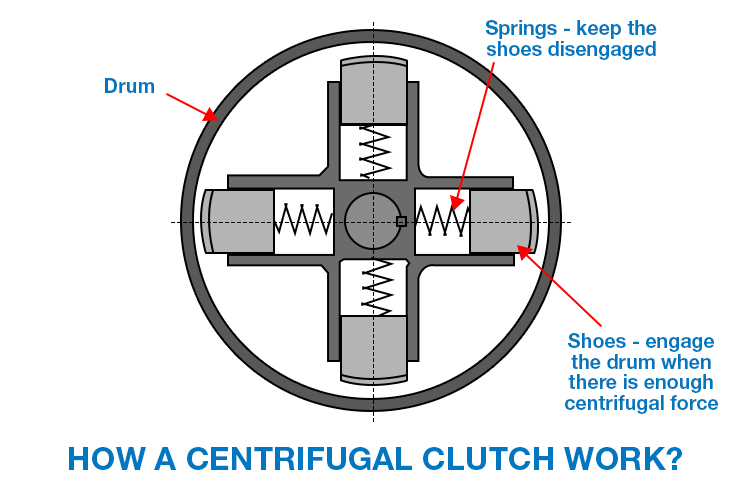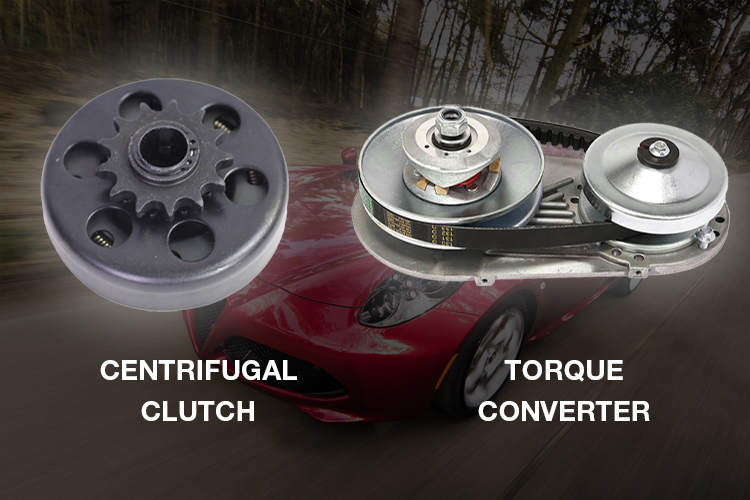[ad_1]
Have you ever wondered what the difference is between a centrifugal clutch and a torque converter? In this article, we will discuss the differences between these two types of mechanical devices, their pros, cons, and application.
| Centrifugal clutch | Torque converter | |
| Mechanism | Centrifugal force | Hydraulic power |
| Gear ratio | Fixed | Variable |
| Slip and overheat | At low RPM | No |
| Price | Cheaper, but higher in the long run if it’s not used the right way | Slightly more expensive at first |
| Maintain | Easier but more regular | Harder to maintain |
| Top speed | Higher | Lower |
| Applications | Racing go-karts, mill saws, etc. | Off-road go-karts, automatic transmission cars, etc. |
The main differences between centrifugal clutch and torque converter

How does a centrifugal clutch work?
A centrifugal clutch is a type of clutch that uses centrifugal force to engage and disengage the drive mechanism automatically.
As the engine turns, it generates centrifugal force within the clutch. The centrifugal force generated increases as the speed input increases. This means that slower speeds produce less centrifugal force, and faster speeds produce more centrifugal force.
When the centrifugal force reaches a certain level, it overcomes the spring tension and causes the clutch to engage. The drive and driven components are then connected. The centrifugal force decreases when the input speed decreases and the clutch disengages, separating the drive and driven components.
How does a torque converter work?
A torque converter is a type of fluid coupling that uses the principle of hydrodynamics to transmit power from an engine to a driven component.
The torque converter consists of:
- The housing holds other components inside.
- The impeller is inside the housing and connects to the transmission.
- The turbine is inside the housing and connects to the transmission.
- The transmission fluid is contained between the impeller and turbine, transferring the power generated by the impeller to the turbine.
- The stator is located at the center of the housing.
When the engine crankshaft turns, which makes the impeller turn. This pushes the transmission fluid to the outsides of the turbine. The fluid’s force causes the turbine to rotate, which in turn rotates the transmission shaft.
The fluid also flows back toward the impeller due to the turbine’s rotation. When the fluid moves through the housing center, it passes by the stator. It redirects the liquid back into the turbine rather than into the pump. This increases the torque that is put on the transmission shaft.
Centrifugal Clutch vs. Torque Converter: Pros and Cons

Centrifugal Clutch
Generally, when the engine runs at 1,400 – 1,600 RPM, the centrifugal force will be strong enough to push the friction shoes out, but it won’t be enough to make full contact with the drum yet. This creates heat, wear on the components, and sometimes smoke!
Eventually, at about 1,800 RPM the centrifugal force will be great enough to push the friction shoes against the drum, and the clutch will be fully engaged. Once it does, you can feel it’s really grasping.
Changing the springs inside your centrifugal clutch will allow you to adjust the particular RPM where it’s engaged. Stiffer springs will increase the RPM at which it’s fully engaged, and softer springs will decrease it.
In addition, centrifugal clutches are a non-variable transmission. This means it will maintain the same gear ratio no matter how fast or slow you’re going. So, if you need to go up a hill and your gear ratio is not high enough, you’ll have to rev the engine pretty high.
Pros
- Inexpensive
- Simple design
- Easy to maintain
- Changing to the right springs will precisely control the engaging RPM
- Higher top speed
Cons
- Slippage
- Overheating caused by friction between drum and shoes
- Limited power transmission – cannot handle high torque
- You must choose between torque or speed
- Easy to burn out if not oiled regularly. Therefore, it’s more expensive in the long run.
Torque Converter
Before engaging, the torque converter will idle, and it’ll start to engage at about 1,700 RPM. Because torque converters use transmission fluid to transfer the power, less wear and heat are generated, no matter how slowly you drive.
The gear ratio is also variable, so you can go up hills without revving the engine too high. And, if you have a lot of high torque at low RPMs (like when towing), the torque converter will be able to handle it much better. If you do this with a centrifugal clutch, it’ll just slip and smoke all over the place.
Pros
- With variable gear ratio, you can ride your vehicles in different terrain
- The car will accelerate more quickly from a stop
- Can handle more power than a clutch
- Better speed overall
Cons
- Slightly more expensive
- Less power transfer efficiency
- Slower top speed
- Belts wear out very fast if the system is overloaded.
Centrifugal Clutch vs. Torque Converter: Applications
When it comes to choosing between a centrifugal clutch and torque converter, there are a few things you need to take into account: the type of vehicle, the type of terrain you’ll be driving on, and your driving style.
Centrifugal clutches are commonly used in go-kart racing because the engine constantly runs at top speed. It’s also used in tools like chippers and sawmills.
On the other hand, torque converters are mostly used in automotive applications. They’re found in cars, trucks, and boats because they allow the engine to run at different speeds. If you’re building an off-road go-kart, or you’ll be driving on a variety of terrain, then a torque converter is the better option.
See Also — How Much Does a Car Engine Weigh?
[ad_2]
Source link
